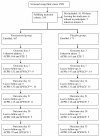Paracetamol versus placebo in treatment of non-severe malaria in children in Guinea-Bissau: a randomized controlled trial
- PMID: 21631932
- PMCID: PMC3123603
- DOI: 10.1186/1475-2875-10-148
Paracetamol versus placebo in treatment of non-severe malaria in children in Guinea-Bissau: a randomized controlled trial
Abstract
Background: The current guidelines for treatment of malaria include paracetamol to children with fever. No convincing evidence for the beneficial effects of this practice exists. Studies show that time to parasite clearance is significantly longer in children treated with paracetamol, which questions the policy. Whether this is of clinical importance has not been investigated.
Methods: Children with Plasmodium falciparum monoinfection and ≥20 parasites per 200 leucocytes at the Bandim Health Centre, Guinea-Bissau were randomized to receive paracetamol or placebo together with chloroquine for three days in a double blind randomized study. Temperature and symptoms were recorded twice daily during treatment and on day 3. The participants were interviewed and a malaria film taken once weekly until day 35. The data is in the form of grouped failure-times, the outcome of interest being time until parasitaemia during follow-up. Mantel-Haenszel weighted odds ratios are given. Other differences between and within the two groups have been tested using the Chi-square test and Mann-Whitney U test.
Results: In the evening of the day of inclusion, the temperature was slightly, but statistically insignificant, higher in the placebo group and significantly more children complained of headache. At no other time was a significant difference in temperature or symptoms detected. However, 6 children from the placebo-group as compared to two children from the paracetamol-group were admitted to hospital with high fever and convulsions by day 3. No differences in the cumulative percentages of children with adequate clinical and parasitological response were found in the intention-to-treat analysis or in the per-protocol analysis.
Conclusion: Fewer children had early treatment failure and the mean temperature was slightly lower in the afternoon on day 0 in the paracetamol group. However, the cumulative adequate clinical and parasitological cure rates were not significantly different during the period of study. It is doubtful whether adding paracetamol to the treatment of uncomplicated malaria in children is beneficial.
Trial registration: NCT00137566.
Figures

References
-
- El-Radhi AS. Is Fever Beneficial? Berlin: Springer-Verlag; 2009.
Publication types
MeSH terms
Substances
Associated data
LinkOut - more resources
Full Text Sources
Medical

